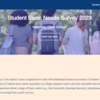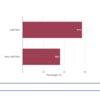The national conversation around students’ basic needs insecurity has progressed over the years; basic needs insecurity (BNI) is increasingly viewed as foundational to student success and the ability for students to successfully fulfill their postsecondary goals. Our own research also shows that BNI is a justice issue as systemically marginalized students experience basic needs insecurity at disproportionate rates. Addressing these equity gaps is not only a human rights mandate, but required for the sustainability of institutions. At Hope, we believe data is a path toward the solution.
Colleges and universities need quality, comprehensive, disaggregated data to assess the needs of their students and to appeal for help in serving those students. The Hope Center’s new Data Dashboard makes that possible.

Over the last decade, The Hope Center has been working alongside colleges and universities around the country to build awareness of the challenges that students face in securing their basic needs. We do this through our Student Basic Needs Survey and an array of collaborative research projects and technical assistance programs. The pandemic’s unprecedented disruptions to higher education and the broader U.S. economy has made our work even more crucial. More and more institutions are recognizing that their students need support and are taking proactive steps to provide that support.
Our commitment to helping institutions develop and implement equitable, systemic, and sustainable approaches to supporting students’ basic needs drove us to create the Hope Impact Partnerships (HIP) model. Through HIP, we’re helping 65 partners across 80 campuses utilize high-quality data while also delivering programming and coaching to help them identify actionable steps to build momentum for change on their campuses.
This week we’re releasing an exciting new tool in supporting these goals: our newly developed data dashboard. The dashboard provides dynamic visualizations of each institution’s Student Basic Needs Survey data across the following topic areas:
- overall basic needs insecurity
- food insecurity
- housing insecurity
- homelessness
- mental health
- families and
- support utilization
In addition to institution-level data, the dashboard allows our partners to disaggregate their data by several demographic factors, including:
- race and ethnicity
- gender
- sexual orientation
- Pell Grant-recipient status
- enrollment status and
- parenting status

This capability answers The White House’s recent call for colleges and universities to “bolster hunger, nutrition, and physical activity research and data collection disaggregated by factors, including race, ethnicity, and other demographic and social factors.” Users will also be able to compare their institution’s data to other HIP institutions of similar type (i.e., 2-year/4-year) and state.
The dashboard also offers quick access to our latest policy, research, and practice publications. These resources contain guidance on leveraging state and federal policies to benefit students while also advocating for systemic change, examples of effective programs and initiatives to enhance your institution's basic needs support ecosystem, and evidence of the basic needs challenges faced by various student populations and the impact of interventions designed to support them.
In addition to the dashboard, we’re giving our HIP partners access to our new Hope Center Basics on Basic Needs learning modules. The modules include a series of videos and supplementary resources designed to provide a masterclass for building awareness of today’s students and best practices to support their basic needs. We all have a part to play in creating a sustainable campus ecosystem in which all students’ are able to secure their basic needs. To that end, the modules are accessible to a broad audience so that they can be employed as classroom learning material, professional development for faculty and staff, and a call to action for campus decision-makers.
Our vision is for the dashboard, learning modules, and resources to help our partners better understand the challenges faced by their students and to provide them with the information and tools needed to take informed, decisive action for their students.
Looking ahead, we plan to continue expanding the dashboard’s disaggregation capabilities, incorporating insights and experiences from our institutional partners to ensure the dashboard continues to address their needs and the evolving challenges that students face. We also hope to broaden dashboard access to policymakers and other key higher education stakeholders to guide their efforts to transform how colleges, universities, and the country’s social safety net work to meet the multifaceted needs of today’s students as they pursue their postsecondary credentials.
The higher education landscape continues to reckon with the challenges of declining enrollment, systemic inequities, and the ongoing impacts of the COVID-19 pandemic. Amidst this upheaval and uncertainty, we have an unprecedented opportunity to realize a systemic, lasting transformation in how colleges and universities support students’ basic needs.
Will you join us in seizing it?


